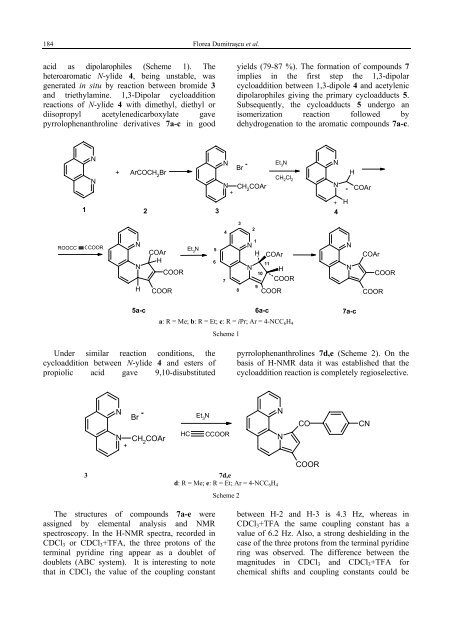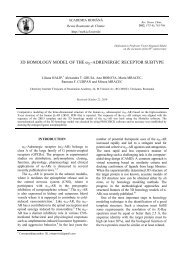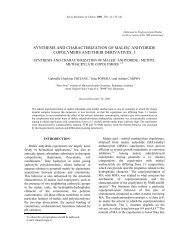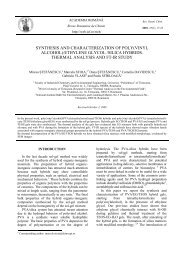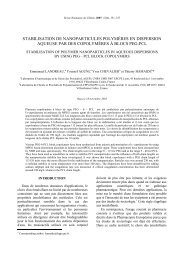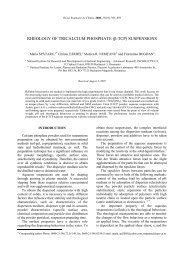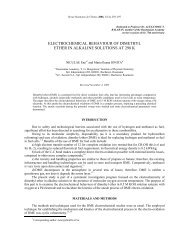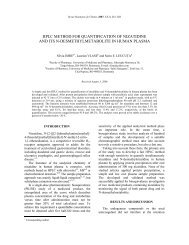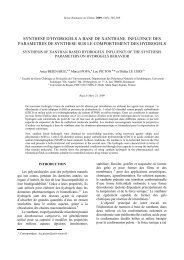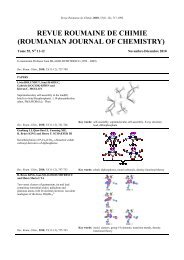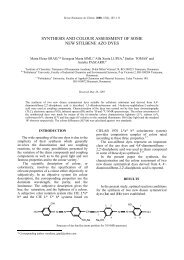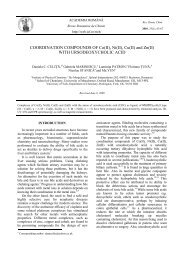184 Florea Dumitraşcu et al.acid as dipolarophiles (Scheme 1). Theheteroaromatic N-ylide 4, being unstable, wasgenerated in situ by reaction between bromide 3and triethylamine. 1,3-Dipolar cycloadditionreactions of N-ylide 4 <strong>with</strong> dimethyl, diethyl ordiisopropyl acetylenedicarboxylate gavepyrrolo<strong>phenanthroline</strong> <strong>derivatives</strong> 7a-c in goodyields (79-87 %). The formation of compounds 7implies in the first step the 1,3-dipolarcycloaddition between 1,3-dipole 4 and acetylenicdipolarophiles giving the primary cycloadducts 5.Subsequently, the cycloadducts 5 undergo anisomerization reaction followed bydehydrogenation to the aromatic compounds 7a-c.NN - Et 3NNBr+ ArCOCH 2BrCHN2Cl 2N CH 2COArN++1 2 3 4H- COArH432ROOCC CCOORNNHCOArHCOORCOOREt 3N5678NHN111<strong>10</strong>9COArHCOORCOORNNCOArCOORCOOR5a-c 6a-c 7a-ca: R = Me; b: R = Et; c: R = iPr; Ar = 4-NCC 6 H 4Scheme 1Under similar reaction conditions, thecycloaddition between N-ylide 4 and esters ofpropiolic acid gave 9,<strong>10</strong>-disubstitutedpyrrolo<strong>phenanthroline</strong>s 7d,e (Scheme 2). On thebasis of H-NMR data it was established that thecycloaddition reaction is completely regioselective.NN+-BrCH 2COArHCEt 3NCCOORNNCOCN3 7d,ed: R = Me; e: R = Et; Ar = 4-NCC 6 H 4Scheme 2COORThe structures of compounds 7a-e wereassigned by elemental analysis and NMRspectroscopy. In the H-NMR spectra, recorded inCDCl 3 or CDCl 3 +TFA, the three protons of theterminal pyridine ring appear as a doublet ofdoublets (ABC system). It is interesting to notethat in CDCl 3 the value of the coupling constantbetween H-2 and H-3 is 4.3 Hz, whereas inCDCl 3 +TFA the same coupling constant has avalue of 6.2 Hz. Also, a strong deshielding in thecase of the three protons from the terminal pyridinering was observed. The difference between themagnitudes in CDCl 3 and CDCl 3 +TFA forchemical shifts and coupling constants could be
1,<strong>10</strong>-<strong>phenanthroline</strong> <strong>derivatives</strong> <strong>with</strong> <strong>potential</strong> <strong>antitumoral</strong> <strong>activity</strong> 185explained as being due to protonation of N-2 bytrifluoroacetic acid.Interestingly, in the H-NMR spectra ofcompounds 7b,e the methylenic protons in theester group appear as two ABX 3 systems. Also, themethyl groups in each isopropyl radical(compound 7c) were found to be non-equivalent inthe H-NMR spectrum, as well as in the C-NMRspectrum. As previously reported <strong>10</strong>,13,14 themagnetic non-equivalence of methylenic protonsand methyl groups represents good evidence forhelical distortion of the pyrrolo<strong>phenanthroline</strong>tetracyclic system.The C-NMR spectra for compounds 7 showedall the expected signals. The chemical shifts for thecarbon atoms were assigned from H/C correlationexperiments.When the cycloaddition reactions betweenN-ylide 4 and esters of acetylenenedicarboxylicacid were performed in the presence of an excessof triethylamine, the dihydro <strong>derivatives</strong> 6 wereisolated as sole product, or along <strong>with</strong> smallquantities of the corresponding aromatizedcompounds 7.The structures of dihydro <strong>derivatives</strong> 6b,c werededuced on the basis of NMR spectroscopy forrepresentative compound 6a. The positions for thetwo protons of the pyrrolinic ring were assigned onthe basis of their multiplicity, viz. two doublets<strong>with</strong> J = 4.5 Hz, as well as the high chemical shiftsof 7.58 ppm, attributed to H-11. The low value ofthe vicinal coupling constant between H-<strong>10</strong> and H-11 indicates a trans configuration. In the aromaticregion of compound 6a, the protons of the terminalpyridine ring show an ABC system due to H-2,H-3 and H-4, whereas the other protons from thepyrrolo<strong>phenanthroline</strong> moiety appeared as two ABsystems (J 5,6 = 8.5 Hz; J 7,8 = 9.6 Hz).Also, the position of the double bond in thepyrroline moiety was evident from the chemicalshifts of the three carbonyl groups. Thus, the largedifference between the two carbonyl ester groups(δ = 165.8 ppm and 173.5 ppm) show that they area attached to Csp 2 (δ = 165.8 ppm) and Csp 3(δ = 173.5 ppm) centres, respectively. Thedeshielding of the carbonyl group of the4-cyanobenzoyl moiety (δ = 188.6 ppm) by 6 ppmrelative to those of the corresponding aromaticcompounds 7a (δ = 182.5 ppm) is good evidencethat the radical is attached to a Csp 3 centre.The formation of dihydro<strong>derivatives</strong> 6 wasexplained by the regio- and stereoselectiveprototropic rearrangement of the primarycycloadducts 5 in the presence of an excess oftriethylamine. The dihydro derivative 6a could beeasily aromatized to the correspondingpyrrolo<strong>phenanthroline</strong> <strong>with</strong> the oxidant tetrakispyridinoCo(II)dichromate (TPCD). This reagentwas used for aromatization of cycloadductsobtained by reaction between heteroaromatic N-ylides and activated olefines. 17-19EXPERIMENTALMelting points were determined on a Boetius hot plate andare uncorrected. The NMR spectra were recorded on a VarianGemini 300 BB instrument, operating at 300 MHz for H and75 MHz for C. Supplementary evidence was given byHETCOR and COSY experiments.1-[2-(4-cyanophenyl)-2-oxoethyl]-1,<strong>10</strong>-phenanthroliniumbromide (3). 4 g (20 mmol) 1,<strong>10</strong>-Phenanthroline hydrate and5.5 g (22 mmol) 2-bromo-4'-cyanoacetophenone in 80 mLacetone were refluxed for 12 h. The precipitate was filtered bysuction and washed <strong>with</strong> water and acetone. Yield 76 %, m.p.245-7 °C (from ethanol). Anal. Calcd. for C 21 H 14 BrN 3 O: C62.39, H 3.49, Br 19.77, N <strong>10</strong>.39. Found: C 62.77, H 3.74, Br20.11, N <strong>10</strong>.60.1 H-NMR (300 MHz, DMSO-d 6 ) δ: 7.25-7.35 (bs, 2H,CH 2 ); 8.23 (d, 2H, J = 8.5 Hz, H-3', H-5'); 7.90 (dd, 1H,J = 8.2, 4.3 Hz, H-8); 8.36 (d, 2H, J = 8.5 Hz, H-2', H-6'); 8.41(dd, 1H, J = 4.3, 1.7 Hz, H-9); 8.48, 8.57 (2d, 1H, J = 8.9 Hz,H-5, H-6); 8.64 (dd, 1H, J = 8.2, 5.9 Hz, H-3); 8.78 (dd, 1H, J= 8.2, 1.7 Hz, H-7); 9.62 (dd, 1H, J = 8.2, 1.4 Hz, H-4); 9.69(dd, 1H, J = 5.9, 1.4 Hz, H-2).13 C-NMR (75 MHz, DMSO-d 6 ) δ: 69.4 (CH 2 ); 115.9,118.1 (CN, C-4'); 124.8 (C-3); 125.5 (C-8);; 127.0 (C-6);128.8 (C-2', C-6'); 130.7 (C-5); 131.5, 132.0(C-4a, C-6a);136.0, 137.6, 138.2 (C-<strong>10</strong>a, C-<strong>10</strong>b, C-1'); 133.3 (C-3', C-5');138.1 (C-7); 148.2 (C-4); 148.6 (C-9); 152.0 (C-2); 189.7(CO).Trans dimethyl 11-(4-cyanobenzoyl)-<strong>10</strong>,11-dihydropyrrolo[1,2-a][1,<strong>10</strong>]<strong>phenanthroline</strong> -9,<strong>10</strong>-dicarboxylate (6a).2.0 g (5 mmol) cycloimmonium bromide 3 and 5.5 mmolDMAD were suspended in 25 mL of methylene chloride. Themixture was cooled at 0 °C (ice bath), and 6 mmol oftriethylamine dissolved in 5 mL of methylene chloride werethen added under stirring, over 5 min. Stirring was continuedfor 20 min after which the reaction mixture was washed <strong>with</strong>water and the solvent removed at room temperature. Theresidue was triturated <strong>with</strong> ethanol, filtered and air dried. Theproduct was recrystallized from acetonitrile and red crystals<strong>with</strong> mp 230-3 °C were obtained; yield 91 %. Anal. Calcd.C 27 H 19 N 3 O 5 : C 69.76, H 4.11, N 9.03. Found: C 70.01, H4.23, N 9.18.1 H-NMR (300 MHz, CDCl 3 ) δ: 3.70, 3.85 (2s, 6H, 2Me);4.09 (d, 1H, J = 4.5 Hz, H-<strong>10</strong>); 7.22 (dd, 1H, J = 8.2, 4.2 Hz,H-3); 7.37, 7.47 (2d, 2H, J = 8.5 Hz, H-5, H-6); 7.44 (d, 1H,J = 9.6 Hz, H-7); 7.58 (d, 1H, J = 4.5 Hz, H-11); 7.88 (d, 1H,J = 9.6 Hz, H-8); 7.90 (d, 2H, J = 8.6 Hz, H-3', H-5'); 7.91(dd, 1H, J = 4.2, 1.8 Hz, H-2); 8.02 (1H, dd, J = 8.2, 1.8 Hz,H-4); 8.27 (d, 2H, J = 8.6 Hz, H-2', H-6').13 C-NMR (75 MHz, CDCl 3 ) δ: 49.6 (C-<strong>10</strong>); 50.4, 52.4(2MeO); 71.0 (C-11); 88.2 (C-9); 116.5, 117.9 (C-4', CN);119.7 (C-8); 121.0, 126.8 (C-5, C-6); 121.9 (C-3); 122.0,130.3, 135.2, 137.1, 137.3 (C-4a, C-6a, C-12a, C-12b, C-1');


